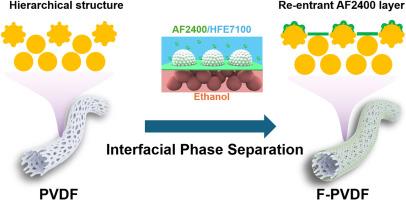在膜表面构建可重入式超疏水结构,实现抗湿膜蒸馏
IF 9
1区 工程技术
Q1 ENGINEERING, CHEMICAL
引用次数: 0
摘要
膜蒸馏(MD)的实际应用仍然受到膜润湿和结垢的限制,特别是在存在低表面张力污染物和无机垢的情况下。传统疏水膜表面氟化的氟化改性方法仅实现了化学改性,进而提高了抗湿、抗垢性能,但难以通过构建氟化材料的二级结构来实现效果的最大化。在本研究中,我们引入了一种界面相分离方法,在层次化聚偏氟乙烯(PVDF)膜表面生成纯含氟聚合物(AF2400)结构。最佳的AF2400层具有薄而多孔的结构,可产生二次再入口。改性后的膜具有更强的抗湿性和抗结垢性,在0.6 mM十二烷基硫酸钠(SDS)溶液作为饲料的情况下可以稳定运行16小时,在含有0.2 mM SDS和20 mM石膏的混合污染饲料溶液中可以稳定运行30小时。分层形态和工程表面化学的协同作用有助于提高膜的坚固性和长期性能。这些结果强调了一种可扩展和有效的方法来制造具有强大的抗润湿和抗结垢性能的先进MD膜。本文章由计算机程序翻译,如有差异,请以英文原文为准。

Constructing re-entrant superhydrophobic structures on membrane surface for robust anti-wetting membrane distillation
The practical application of membrane distillation (MD) remains limited by membrane wetting and scaling, particularly in the presence of low surface tension contaminants and inorganic scalants. The traditional fluorination modification method of hydrophobic membrane surface fluorination only realizes the chemical modification and then improves the anti-wetting and anti-scaling performances, but it is difficult to maximize the effect by constructing the secondary structure of fluorinated material. In this study, we introduce an interfacial phase separation method to create pure fluoropolymer (AF2400) structure on the surface of hierarchical polyvinylidene fluoride (PVDF) membranes. The optimal AF2400 layer features thin and porous structure generating a secondary re-entrant. The modified membranes exhibited enhanced resistance to both wetting and scaling, maintaining stable MD operation for 16 h with a 0.6 mM sodium dodecyl sulfate (SDS) solution as feed and for 30 h with a mixed foulant feed solution containing 0.2 mM SDS and 20 mM gypsum. The synergistic effect of hierarchical morphology and engineered surface chemistry contributed to improved membrane robustness and long-term performance. These results highlight a scalable and effective approach to fabricating advanced MD membranes with robust anti-wetting and anti-scaling performance.
求助全文
通过发布文献求助,成功后即可免费获取论文全文。
去求助
来源期刊

Journal of Membrane Science
工程技术-高分子科学
CiteScore
17.10
自引率
17.90%
发文量
1031
审稿时长
2.5 months
期刊介绍:
The Journal of Membrane Science is a publication that focuses on membrane systems and is aimed at academic and industrial chemists, chemical engineers, materials scientists, and membranologists. It publishes original research and reviews on various aspects of membrane transport, membrane formation/structure, fouling, module/process design, and processes/applications. The journal primarily focuses on the structure, function, and performance of non-biological membranes but also includes papers that relate to biological membranes. The Journal of Membrane Science publishes Full Text Papers, State-of-the-Art Reviews, Letters to the Editor, and Perspectives.
 求助内容:
求助内容: 应助结果提醒方式:
应助结果提醒方式:


